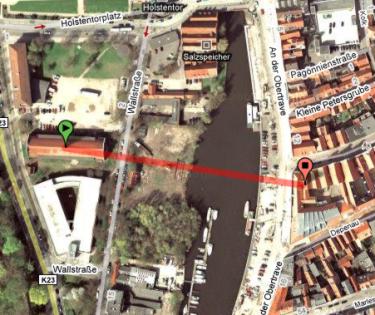| Pro-Music-News™ |
Projects & Productions |
Musikhochschule Lübeck uses optical gigabit connection for real-time audio
The technologies by which sound and data are transmitted allow for ever increasing quality and reliabilty. A facility in the German city of Lübeck has taken this to the next level. Housed in 17th century buildings, the Musikhochschule Lübeck (MHL) has historically been a home for the very best in German classical music, with historic rooms for organ and piano recitals featuring optimum acoustics, as well as recording and rehearsal facilities. One of the MHL’s inherent disadvantages is that the recital rooms and recording studios are located on opposite sides of the River Trave, which divides the city.
 "New recording studios and rehearsal rooms were built in 2007 and, when we planned the network connection between the buildings, the cost of a fibre optic network would have been prohibitive, due to the requirement for a new bridge across the river to carry the cable, plus an annual fee for taking it across public ground," says MHL chief sound engineer Thomas Fricke-Masur. "New recording studios and rehearsal rooms were built in 2007 and, when we planned the network connection between the buildings, the cost of a fibre optic network would have been prohibitive, due to the requirement for a new bridge across the river to carry the cable, plus an annual fee for taking it across public ground," says MHL chief sound engineer Thomas Fricke-Masur.
Going wireless seemed to be the only solution. Eventually, the initially disruptive topography supported a reliable and cost-effective solution as intervisbility between both facilities allowed for using an optical connection using a highly directed laser beam. TereScope provides high bandwidth using a technology similar to that found in fiber optics communications, providing full-wire data rate using optical signals. In addition, the narrow and invisible laser beam makes it a highly secure wireless solution, at the location in Lübeck only affected by heavy mist which occurs less than twice a year. These systems, without the need for right-of-way or government permits for installation, provide a license-free technology.
"It was far more cost effective to install a one gigabit wireless, laser solution. At the same time we considered EtherSound for patching and routing for the new studio and wondered whether audio transfer would be possible across the laser link? The idea was to make recordings with musicians playing simultaneously in the new studio and in one of the recital rooms of the old Musikhochschule buildings on the far side of the river - for example with a pipe organ or an orchestra," Fricke-Masur continues.
In order to test the system, Yamaha Music Europe GmbH Broadcast Sales Engineer Arthur Koll took an SB-168ES stage box and linked it to the laser network which immediately communicated perfectly with the MY-ES card installed in a DM2000 on the far side of the river. The total system latency from the input on the DM2000 to the analogue output on the SB168 was just 2.3 milliseconds.
So successful was the test that Thomas Fricke-Masur soon arranged the recording session combining rooms on each side of the river. "I invited two musicians from the jazz trio Triologue - Olaf Koep on drums and Alex Carot on Chapman Stick,” says Thomas. “The player in the recital room on the far side of the river received his monitor mix via the Yamaha SB168-ES, the laser transmission system and the DM2000 console. The guy in the studio was connected conventionally to the recording console. Although the two played very timing critical stuff there were absolutely no problems playing over this network. The session was a complete success." |
© 10/2009 pro-music-news™
© 1997 © 2009 Pro-Music-News™. All rights reserved. Thank you for visiting Pro-Music-News™.
|